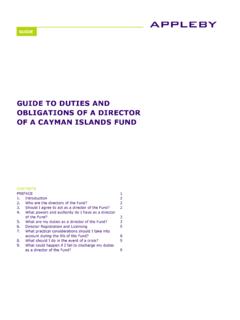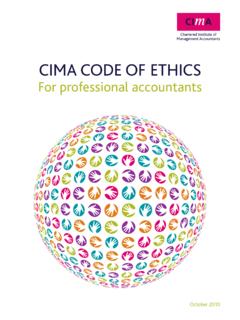Transcription of Board Development and Accountability Linda Manley, …
1 Board Development and Accountability Linda Manley, Legal Director Lawyers Alliance for New York I. Introduction II. The Role of the Board A. Operation of Boards. The not for profit corporation is to be managed by the Board . N-PCL 701. 1. This does not mean micro-managing the organization's day to day operations. In managing the organization's internal affairs, boards are usually involved in two key areas: a. Oversight , of budget, fiscal controls, resource allocation, programs and key staffs. b. Making decisions to key to the life and direction of the organization selecting the principal executive, establishing programmatic objectives, approving long-range plans, acquiring or disposing of real property and refining the organization's mission. c. In addition, boards are often involved in managing the corporation's external affairs - - , fundraising, organizing volunteers and raising public awareness.
2 D. For new, developing or very small organizations, there may be a transition period when directors are much more involved in the day to day operations of the organization. B. Serving on the Board of directors of a not-for-profit corporation carries with it important responsibilities and obligations. 1. Board structure and governance are important to maintaining public trust in charitable organizations. 2 a. A not for profit corporation must be duly constituted and follow certain procedures in order to effectuate corporate action. b. A not for profit corporation must show that it in fact followed proper governance procedures in order to obtain funding. c. An organization's financial or legal problems can often be traced back to action, or inaction, of Board members who either were unaware of their legal obligations or chose to ignore them. d. By helping to ensure that directors and officers are mindful of their responsibilities, you are helping the organization protect its assets and carry out its charitable purpose.
3 2. This is particularly important at a time such as this when charitable organizations are being subject to heightened scrutiny. 3. Two forces influencing boards: a. Statutory and Regulatory Provisions b. Sector wide "best practices" being promulgated by watch-dog groups. 4. The New York Not-for-Profit Corporation Law (NPCL) sets forth the detailed rules regarding the governance of not for profit corporations operated in New York. 5. Statutory Mandates and Operation of Boards of Directors a. N-PCL has few mandates on structure and operation of Boards. (i) The Board of Directors of a not-for-profit corporation must have at least three members. N-PCL 702. (ii) The Board of Directors must exercise the duty of care in making decisions and taking actions on behalf of the corporation. N-PCL 717. b. The only qualification for Board members is age - generally they must be eighteen years of age.
4 N-PCL 701. (i) There are exceptions for youth groups. 3 c. The way boards operate is guided by statute and regulation, the Board s fiduciary duties and best practices suggested by regulatory agencies and shaped by watchdog groups and nonprofit practitioners. C. Fiduciary Duties of the Board of Directors. See generally, N-PCL Article 7. 1. Duty of Care requires that directors and officers be attentive to the organization's finances and activities and actively oversee the way in which assets are managed. N-PCL 717. a. Directors and officers shall discharge the duties of their respective positions in good faith and with that degree of diligence, care and skill which ordinarily prudent men would exercise under similar circumstances in like positions. N-PCL 717(a). See Committee to Save Adelphi v. Diamandopoulous, et al. ( Board of Regents decision dated February 5, 1997); Dennis C.
5 Vacco v. Peter Diamandopoulos, et al., 715 269 (1998) for analysis of failure to exercise duty of care. b. Directors and officers can rely in good faith on information, opinions, reports or statements made by other officers, directors or outside experts. N-PCL 717(b). c. Essentially, directors must use common sense, be diligent and attentive to the organization's management and attempt to make sound and informed decisions. See N-PCL 701(a) and 717. d. Board members have a responsibility to ensure that charitable assets are spent appropriately. (i) Board members may be held liable for the waste or loss of charitable assets through their negligence, or for permitting improper distribution of corporate assets. The Attorney General has standing to sue directors for losses suffered by not-for-profit corporations as a result of breaches of fiduciary duties.
6 See Vacco v. Aramony, , Aug. 7, 1998, p. 21 (Sup. Ct. County July 13, 1998) (ii) Therefore, Board should regularly review organization's finances, should participate in setting compensation levels and hire competent accountants and auditors. 4 e. Investment of charitable assets (i) New York State has special rules with regard to investment of organizational assets. (ii) The Board may invest in any real or personal property it deems advisable. N-PCL 5 (iii) When making investment decisions the Board should consider the long and short term financial needs of the corporation, its cash requirements and general overall economic conditions. N-PCL 717(a). (iv) Investment authority can be delegated to staff members as long as the Board exercises its duty of care. N-PCL 514(b) and 717. f. Restricted assets (i) When assets have been donated for a specific purpose they must be used for that purpose unless otherwise approved by the donor or directed by court order.
7 N-PCL 513, 522. g. Guidelines to evidence participation and role of the Board : (i) Scheduling of regular Board meetings (and maintenance of minutes and resolutions); Board members should review and approve minutes. (ii) Establishing committees to delegate specific responsibilities (iii) Circulation of relevant information to Board (announcement of new contracts, financial information, performance reviews) (iv) Access to corporate books and records and procedures for monitoring finances h. Unclear whether the business judgment rule, which bars judicial inquiry into actions of corporate directors taken in good faith and in the exercise of honest judgment in the lawful and legitimate furtherance of corporate purposes, applies to nonprofits. See Aurebach v. Bennett, 47 619, 629 (1979) (applying the rule to business corporations); see also Scheuer Family Foundation, Inc.
8 V. 61 Associates, 179 65 (1992) (not reaching 5 this issue because the directors breached their duty of loyalty). In a recent case the New York Court of Appeals presumed that the business judgment rule applied to a decision of not-for-profit directors. Consumers Union of , Inc. v. The State of New York, 2005 LEXIS 1433. 2. Duty of Loyalty - Requires that Board members pursue the interests and mission of the organization with undivided allegiance. See N-PCL 717(a), 102(a)(5), 716 and 715. a. Essential element distinguishing a not for profit from a for profit business is the prohibition on pecuniary profit and financial gain. N-PCL 102(a)(5). Therefore, should have conflict of interest policy. b. Loans - Type B corporations are strictly prohibited from making loans to officers and directors or corporations in which one if its Board members is also an officer or directors or has a financial interest.
9 N-PCL 716. (i) Exception: One Type B to can make a loan to another Type B. c. See discussion of Conflicts of Interest/Excess Benefits Transactions below. d. Doctrine of diversion of corporate opportunity applies to directors of not-for-profit corporations. See American Baptist Churches of Metropolitan New York v. Galloway, 271 92 ( App. Div. 2000). e. Concrete steps for observing Duty of Loyalty (i) Have clear procedures for setting compensation of employees. (ii) A majority of directors should have no financial relationship with the organization. Independent directors should dominate the Board . (iii) Develop written conflict of interest policy that details how transaction with related parties will be considered. The policy should set forth the standards of permissible conduct. Board members should be required to comply with the policy. 3. Duty of Obedience - means assuring that the organization acts within the corporation s purposes and that it fulfills its mission as set forth in the certificate of incorporation.
10 See N-PCL 201-202, 402(a)(2). 6 a. Directors must exercise meaningful oversight to ensure that the organization complies with the law. b. Case law: In re: Manhattan Eye, Ear & Throat Hospital and Memorial Sloan Kettering Cancer Center et al. v. Eliot Spitzer, 715 575 (1999) (the duty of obedience requires that a Board of a not-for-profit corporation be faithful to the purposes and goals of the organization, which required in this case that a proposed transaction to sell or substantially all of a charity s assets promote the purposes of the charitable corporation). D. Liability of Board Members. 1. Generally speaking, Board members are not personally liable for the liabilities of the corporation ( corporate veil concept). a. Section 720-a of the N-PCL provides that uncompensated directors and officers of organizations exempt under 501(c)(3) of the IRC shall not be liable for third-party suits ( , those suits not brought by the NYS AG or the corporation itself) if the director or officer is named solely for his or her conduct in the execution of such office UNLESS (i) the director or officer acted with gross negligence or (ii) intended to cause the harm that resulted to the person asserting liability 2.















